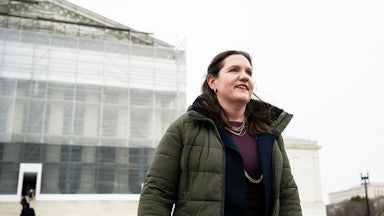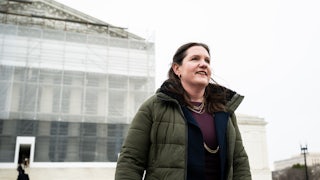On a subtropical overcast late afternoon in January, no bumper-to-bumper vehicles and no horde of pedestrians lurch across the McAllen-Hidalgo International Bridge, usually one of the busier ports of entry in the Rio Grande Valley. Some days, thousands of people and vehicles make the northbound two-hour crossing to Texas from Mexico to work, to shop, to visit family and friends. But little is moving on this day, at this hour, on the eight-lane bridge except the southbound evening rush of pickup trucks, cars, and SUVs returning south to Reynosa, Matamoros, and other towns in the border state of Tamaulipas and farther south to Monterrey.
There is nothing much to mark this international border. No flags, no bright welcome signs. A few guards. A parking lot in a fenced area. Shabby storefronts. Money-changing shops. A diner, Frontera, seems closed, and few cars wait at the bright orange-and-white Whataburger drive-through. Up the road, large banners advertise “ROPA” at big-box warehouses where shoppers buy bulks of cheap used clothing to resell later at a profit.
In the distance, along an open field near the bridge, a rust-color metallic fence rises maybe 30 feet high, rounding across the weedy grounds near the river’s edge. This is a piece of the 55 miles of wall that have been installed, in separate sections, in the three border counties of the Valley—Hidalgo, Cameron, and Starr—at the southeastern tip of Texas.
Sections of the wall, some brown, some black, were put up over the past 10 years or so, in different parts of the valley’s 100-mile river border. Some were built during the Trump administration, others in the Obama years. There’s not much continuity in the construction of the wall, which has been driven mainly by politics through four presidencies: George W. Bush, Barack Obama, Donald Trump, and now Joe Biden.
“The Way McAllen Used to Be”
The highway from the McAllen-Hidalgo International Bridge to McAllen passes scruffy acres of winter-brown grass, cut-rate motels, strip malls, restaurant chains, humble homes, fenced-in hangars, and parking lots for the thousands of commercial cargo trucks that haul merchandise worth billions across the valley’s border crossings—electronics, machinery, petroleum products, tons of fruits and produce. Trade across Hidalgo County’s five international ports of entry totals more than $33 billion, a fraction of the total annual U.S.-Mexico trade of $798 billion last year—$638 billion from the 11 crossings on the Texas border.
It takes 20 minutes or so in light traffic to get to downtown McAllen, a cluster of blocks of low-rise buildings with stucco facades and flat roofs resembling border pueblos.
“It’s the way McAllen used to be 40, 50 years ago, 60 years ago,” says state Senator Juan “Chuy” Hinojosa, a Democrat who was born in McAllen and brags about the city’s growth, the convention center, colleges, trauma hospitals, and La Plaza Mall, the top shopping and dining center in the Valley.
Spindly palm trees, imported in the early 1900s from Sonora and Baja California, hover over streets and parks, giving McAllen a tropical look and the nickname City of Palms. A dozen or so Mexican food trucks sit by a park across from the century-old hotel Casa de Palmas, and a few yards down the street, a rustic-chic bistro, owned by a former migrant worker, serves sophisticated global cuisine. I see no campaign banners, billboards, yard signs, or bumper stickers anywhere ahead of the March 5 primary.
On a drizzly morning, downtown sidewalks are nearly empty. Boutiques display quinceañera gowns, and colorful signs in Spanish advertise perfumerias, lenses, marked-down household goods. Stalls of yellow, red, and blue artificial flowers brighten up the windows of a corner general store. Inside, a big room holds multiple aisles and shelves of baskets and buckets of artificial flowers in all colors, shapes, and sizes. “Mexicans love and honor the Day of the Dead and keep their graves beautiful all year,’’ a clerk tells me in Spanish. “We sell a lot of flowers.’’
The Threat of the New Immigration
The border has always been the stuff of myth, mystery, and violence, and the Rio Grande Valley has its own distinctive character and history. Four counties make up the Valley—Hidalgo, Cameron, Starr, and Willacy—the terrain of hunters and gatherers dating back 11,000 years, when it is said the Coahuiltecans hunted animals, fished, and gathered fruit and roots. The Lipan Apaches and the Comanches arrived in Texas in the eighteenth and nineteenth centuries, and Spanish and Mexican settlers colonized the region and built cattle ranches and vegetable and citrus farms.
Today, the valley has about 1.4 million people, 95 percent Hispanic in a state where Hispanics—Latinos, Tejanos—now constitute a plurality of the population. The most recent census data shows that 40.2 percent of the state’s 30 million residents are Latino, compared to 39.8 percent non-Hispanic whites. Despite the presence of oil refineries, agriculture, and manufacturing, the valley is among the poorest regions of Texas. The average household income is $66,313, compared to the state’s $101,152. And unlike much of Texas, the valley remains Democrat. But Latinos in the border region represent less than a third of the state’s Latino vote. Almost twice as many live in the four largest metroplexes of Houston, Dallas, San Antonio, and Austin, which have Democratic majorities but are surrounded by Republican-leaning suburbs and exurbs.
Cal Jillson, a political science professor at Southern Methodist University and scholar of American politics, looks at it this way: “Hispanic communities have been there for centuries. They are integrated, have good jobs, but now that security is endangered by immigrant newcomers, many more than 10, 20 years ago. They fear they will lose the gains they’ve made. The new immigration threatens the social and cultural fabric.”
It is no surprise that immigration has become the hottest issue of the 2024 election. National polls show Americans increasingly favor the border wall and tougher immigration laws. A recent New York Times/Siena College survey of six battleground states showed 53 percent of respondents favored the border wall, compared with 44 percent who opposed it.
In the Rio Grande Valley, where opposition to the wall had been strong, support has doubled since 2018, according to a study by the University of Texas Rio Grande Valley.
Trump is almost certain to win Texas, where no Democrat has won statewide office since 1994 and no Democratic presidential candidate has won since Jimmy Carter in 1976. Trump could win the valley too. He made inroads there in the 2020 election, though he lost to Biden. But this year, the valley is in play.
Republicans Are Paying Attention
“If you look at what’s happening here around the border, President Biden, unfortunately, was very slow, has been very slow, in moving,’’ Senator Hinojosa admits when we meet in his law office in Edinburg, the prosperous Hidalgo County seat. Hinojosa is 77, with 40 years in Texas politics. He knows immigration intimately. Born in McAllen, he had an American father and a Mexican mother. When he was five years old, he and his mother were deported and for at least a year lived in Reynosa until his father was able to bring them back to the valley.
He warns that the Republican Party is paying much more attention to the valley: “They are investing and setting up infrastructure. And we now have several Republican elected officials.’’
A recent University of Houston poll of Texas Latinos showed Trump up by six points over Biden, the Austin American-Statesman reported. Those numbers, and the election of Congresswoman Monica de la Cruz, a Republican in Latino South Texas, have given Republicans hopes they will get a larger share of the Latino vote in 2024 than they did in 2022.
Matt Angle, a Democratic strategist and director of the Lone Star Project, a political action committee that works with Democratic candidates, says, “De la Cruz lost the Hispanic vote but won on the strength of overwhelming support among Anglos. This dynamic is what the Republicans are shooting for statewide.”
The valley’s Republican turnout in 2022 midterms more than doubled from 2018, according to The Texas Tribune. Democrats maintained a higher turnout, but the GOP narrowed the gap. In Starr County, west of Hidalgo, where Hillary Clinton beat Trump in 2016 by 60 percentage points, Trump lost to Biden in 2020 by just 5 percent. “I do believe that there was an uptick in voters that voted for Trump in 2020,’’ said State Representative Terry Canales, 45, a Democrat who grew up on a ranch and owns 350 head of cattle, more than 50 horses, and over 600 guns. “Trump is an anomaly. I think that anybody, politically, would agree with me, that he’s completely different than any candidate that you’ve ever seen. Trump says, does, and acts in ways that you’ve never seen any candidate act. What I can tell you is that you can attribute that phenomenon to him. So there was growth in Republican numbers. It was because of him.”
Canales points out that the Republican Party latched onto and exploited the notion that Democrats are anti-oil and gas, one of the main sources of livelihood in the valley and Texas generally. “So, if that tends to be, or remains to be, a pivotal issue in the upcoming election, I believe you’ll see the same phenomenon,’’ he said.
The Democratic History
The valley’s allegiance to the Democratic Party dates to the early 1960s, when it was mostly segregated along economic and racial lines. There were powerful Anglos and a few Hispanics leaders, elected officials, old families with ranches and cattle money. But for many Hispanics, it was white Anglo Americans on one side and poor, powerless Hispanics on the other.
That began to change with the Viva Kennedy movement, which appealed to Hispanics and was reinforced when President Lyndon B. Johnson passed the Civil Rights Act of 1964 and the Voting Rights Acts of 1965. A Hispanic middle class began to emerge in the valley: more educated, better trained, more outspoken. The League of United Latin American Citizens, or LULAC, and the United Farm Workers Union of Cesar Chavez and Dolores Huerta grew out of the civil rights movement and gave voice to millions of Hispanics.
This was a very agricultural area then. But over the years that changed. “We now have a very educated group of Hispanics here in the valley,’’ Hinojosa says. “They run businesses, they are professionals, they are doctors, they are lawyers, public officials.”
Despite all that visible progress, corruption runs through the valley. The politiquera system, a Spanish word unique to the border that means “campaign worker,” seems entrenched in valley politics. If a local candidate needs votes, he or she goes to a politiquera, man or woman, who buys and sells votes, a pattern of electoral rigging and fraud that brought in an FBI anti-corruption force in 2014, when more public officials were convicted for corruption in South Texas than in any other region of the country, according to the U.S. Justice Department.
Corruption was part of the patron system, an arrangement or structure between the powerful and powerless common in Latin America. With more power came more corruption, and jobs depended on the boss system, says the high-level official who requested anonymity. The system works particularly well when the powerless are migrants.
Governor Abbott’s Defiance
Over 2.5 million immigrants crossed the 2,000-mile southern border that stretches from Texas to California in the past year, including 300,000 in December alone. Billions of dollars have gone to U.S. Customs and Border Protection, the Homeland Security division that includes the Border Patrol, and billions more have been allocated to other immigration agencies. But none of that has stopped the mass incursion of people from all over the globe to the southern border—and increasingly to the northern border with Canada as well.
Last fall, President Biden, who had not been a supporter of the wall, pushed forward with plans to extend the wall on a 17-mile tract of the Rio Grande Valley. Biden also asked for power to shut down the border entirely when illegal crossings rose above an average of 4,000 a week, which is occasionally happening.
In early February, Republicans killed the first major bipartisan immigration legislation in a decade. The measure, hammered over months in the U.S. Senate, had no chance of passing either chamber of Congress after Trump opposed it, hoping to exploit the border crisis to his benefit in the presidential campaign.
For more than two years, Governor Greg Abbott, who was reelected to a third term in a landslide with 40 percent of the Latino vote in 2022, has been promoting his own stop-immigration campaign, Operation Lone Star. He has defied Biden, the federal government, and even the Supreme Court, claiming—as other Republicans and some Democrats do—that Washington is not doing enough to fix the border.
Abbott has staged his campaign along the Texas border, in McAllen, in Edinburg, and lately in Eagle Pass, a town of 28,000 that voted Republican in 2022. There, near the spot where three migrants, including two children, drowned in the Rio Grande in January, Abbott holds press conferences and photo ops with visiting governors and other high-level officials. He took full control of the 47-acre Shelby Park, an entry point for masses of immigrants, and banned the U.S. Border Patrol from entering the park, where agents used a boat ramp to patrol the Rio Grande, according to The Texas Tribune. On his orders, the state has state agents lay down rolls of razor wire along the park’s border to prevent crossings.
Abbott claims the state’s right of self-defense. But the Supreme Court, in a 5–4 decision in January, ruled that the federal government has sole authority over border security and ordered Abbott to allow the Border Patrol to enter the park and take down the razor wire. Abbott remains defiant.
The Asylum Onslaught
For decades most Mexican immigrants crossing the border were seeking work in California farms and in the factories of the North and Midwest. Crossing the Rio Grande, they avoided entanglements with U.S. border agents and other law enforcement. Eventually, some of the migrants returned voluntarily to Mexico, but others stayed in the U.S, joining an estimated 10 million undocumented immigrants living here.
Few sought political asylum. But that pattern changed after 2010, when many immigrants came from the Northern Triangle—El Salvador, Honduras, Guatemala—trying to escape violence, poverty, and political persecution.
Now most immigrants want political asylum. For them, the first step after crossing the border is to seek—not avoid—U.S. border agents and surrender. The Border Patrol is not a problem. On the contrary, getting arrested is a necessary step to apply for asylum, now the surest way for migrants to stay in the U.S. To qualify for asylum, according to a recent report in The New York Times, migrants must convince a judge that returning to their home country would lead to harm or death. Applicants for asylum can wait years, given the growing caseloads in immigration courts. But during that wait, migrants can stay and work in the U.S. Even when their applications are turned down, many stay.
Millions of migrants pay $5,000 to $20,000 to cartels who control the human trafficking business in Mexico. They have little choice. After the dangerous passage through Mexico, they may be held up in stash houses for ransom, awaiting their chance to cross the river. Once the smugglers collect the money, the migrants are put on rafts to cross into Texas.
The lucky ones who make the crossing are held by Border Patrol agents and taken to detention centers or one-day stops like the Catholic Charities in McAllen. There, they sleep on mattresses on the floor, receive warm meals, and can take showers. McAllen used to receive more migrants than most other cities on the border, maybe 1,000 a day, sometimes more. Now, with the focus on Eagle Pass, the number of migrants coming to McAllen has dropped to 100 or so a day.
Few of them stay in the area, or they go to Houston, Dallas, and farther north to work or reunite with relatives. Other migrants are flown or bused to New York City, San Francisco, Seattle, Chicago, Washington, D.C., cities with liberal Democratic officials whom Abbott is forcing to deal with the crisis.
Immigrant entry flash points can pop up anywhere on the border. One day is McAllen, another day Brownsville, or El Paso, or now Eagle Pass.
“The cartels choose where they want to direct people. For some reason, this port is no longer their focus. The cartels decide they would rather have people in another direction. That is the main reason why it’s moved over there to Eagle Pass. We are a way station.” I am talking with Sister Norma Pimentel, the executive director of Catholic Charities of Rio Grande Valley, who oversees the Humanitarian Respite Center in McAllen. We are meeting in a small office at the back of a hollowed-out two-story building, across from the bus station, not far from wine bars and cantinas, the center of the downtown night life.
Sister Norma is 70, probably the most eminent figure in the valley. Pope Francis has praised her work with refugees and immigrants. Time magazine included her on the list of the 100 most influential people in the world in 2020.
But none of that is reflected in the plain rooms of the center. While we talked, we could overhear children playing below. About 100 immigrants had arrived the night before and now sat in rows at a long table in the kitchen–eating area. Volunteers worked the stove, oversaw jumbo-size pots of beans, chicken stew, and white rice. Oversize carts loaded with groceries filled a pantry. Shelves held individual plastic bags containing sandwiches, fruit, and candy, ready for dispensing to migrants for their journeys.
Sister Norma was born in Brownsville. Her father from was Chiapas, her mother from Matamoros. She has always lived in the valley. At 24, with a bachelor’s in fine arts, her life took a 380-degree turn when she joined the sisters of the Missionaries of Jesus. In the early 1980s, she decided to devote herself full-time to work on immigration, and in 2004 she became executive director of Catholic Charities of the Rio Grande Valley. Ten years later, in 2014, when the valley was getting large numbers of immigrants, she organized the Humanitarian Respite Center. “It’s not a shelter,” she tells me. “It’s for people who arrive and take off. A moment to make sure you’re safe, and you get your ticket for a bus or a plane.”
At the peak of the immigration wave 10 years ago, the McAllen processing facilities reached a breaking point. “When I see children, when I see a mother, I see their vulnerability, and the child is crying, it breaks my heart,” she said. “The conditions where they are, when I saw them in the detention facility, and they were crying and asking me to help them, to get them out of there.… That experience back when I started in 2014, it just broke my heart.”
Which Way to Go?
“Without doubt we have a problem on our Southern border,’’ says Congressman Vicente Gonzalez, a Democrat from McAllen whose 34th district includes much of the valley. “We need to send a clear message to people that you can’t just show up to the Southern border and be released in the country.”
He accuses Republicans in Congress of putting their heads in the sand and ignoring what’s happening. “The Republicans like to say that things are turning in their favor,” Gonzalez said. “But when you look at the numbers, we are winning every single race overwhelmingly.”
Gonzalez, 56, won election to this district last year after six years representing another congressional district. “They have invested millions and millions of dollars trying to target Latinos on the border,” he said. “They do that because in Texas, Latinos are now the majority. The Republicans know how to count, right? For them to stay in power, even at the state level, they need to convince at least a percentage, even a small percentage, of Latinos to start voting Republican. If not, they will eventually lose elections.”
He continued: “If they didn’t have that racist, divisive element within their party, they would have a lot of Latinos, but they can’t seem to shake that off. The rhetoric you hear from the Republican Party is shameful and disgraceful for Latinos. And you know, when you see ‘Latinos for Trump,’ to me it is like seeing ‘Jews for Hitler,’ almost, you know?”
Representative Canales, a state House legislator since 2013, comes from a long line of politicians, ranchers, Democrats. His father, Terry A. Canales, his sister Gabriela, his great uncle, Jose Tomas Canales, a founder of LULAC, all served in the Texas legislature. “I grew up in the middle of South Texas, and what I’ll tell you is that somebody wants to say they’re more Texan than me because I have Democrat or D by my name, what I will tell you, if I had to be honest, is that I think that the limitations placed on people by putting a D or an R by their name are silly,” he said. “I don’t think either of those defines me. And I think that in Texas, in South Texas, in particular—we run as Democrats because you can’t get elected as anything else. But I don’t think that we’re Republican or Democrat. I think we’re a different breed. I’d like to say we’re South Texan. That’s our political party.”
South Texans are pro–border fences, pro–Second Amendment, pro-life, he says: “We are more conservative than your average conservative, in that we truly believe in freedom and that freedom means freedom from government, and we believe that government has no business in our private lives. We are South Texans.”
Canales makes an important point. It’s a point that Texans often make. They are defiantly independent and proud, traditional but visionary. It’s risky to label them or try to pin them down. The valley may be an exception. It seems more of a piece. It is the border. It is binational. It honors its Mexican roots, traditions, religion, festivities. It is bilingual. It may vote Democratic but holds deeply conservative views closely aligned with the Republican Party, especially on immigration and border control, abortion, and other divisive cultural and social issues. Republicans I spoke with predicted that the valley will move in their direction in November. Democrats worried that Republicans were moving in with money and organization acknowledged that at the state and national levels they were not doing enough, not paying attention, taking the valley for granted.
It may not make a difference in the presidential race, but it matters for House seats, and for the crucial Senate race in which Democrat Colin Allred has something of a shot at defeating Ted Cruz. Just when many pundits are saying the political gap in Texas is narrowing, Republican gains in the valley would widen it all over again.








